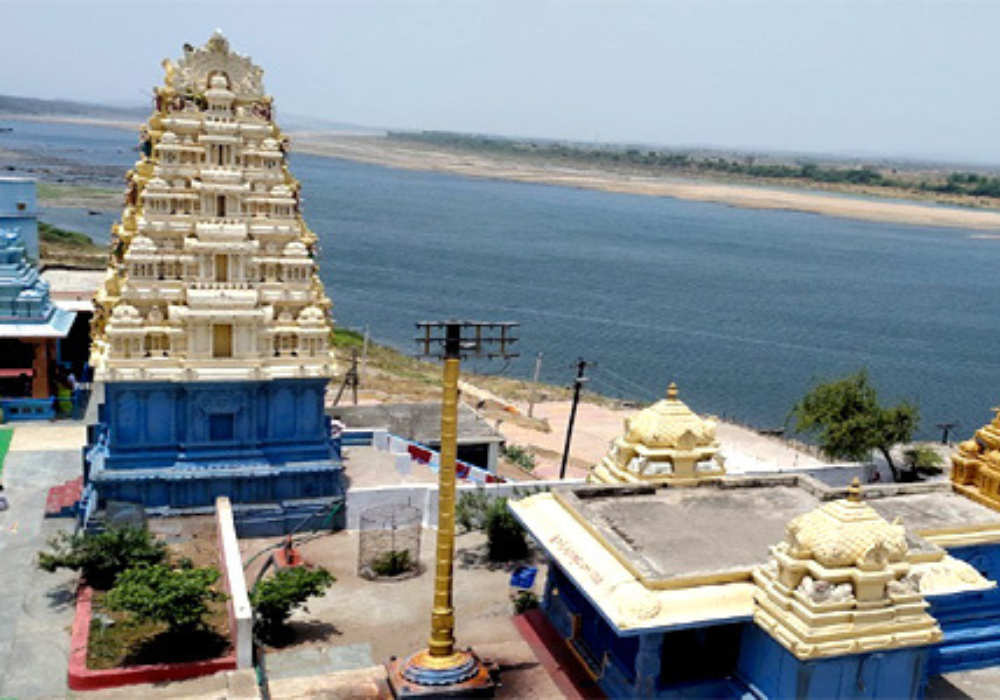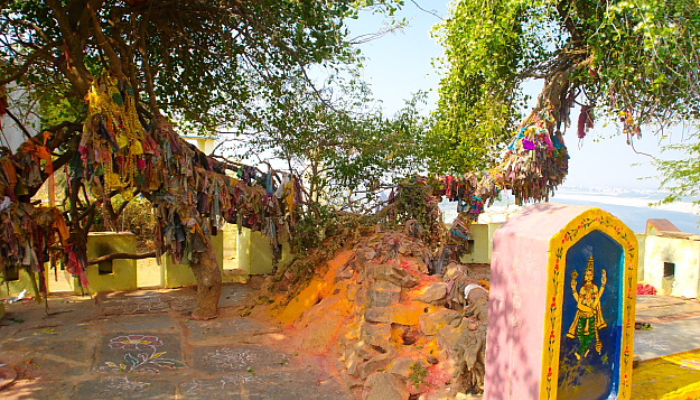
Nestled serenely on the holy banks of the mighty Krishna River in Andhra Pradesh, the Vedadri Temple stands as a profound testament to ancient devotion and architectural brilliance. This revered sanctuary, officially known as the Sri Yogananda Lakshmi Narasimha Swamy Temple Vedadri, is a significant pilgrimage destination. It draws countless devotees seeking spiritual solace and a deeper connection with the divine. The temple’s unique spiritual ambiance and rich mythological narratives make it a truly special place to visit in Vedadri, Andhra Pradesh. This blog post invites you on a virtual journey to explore the captivating history, architectural grandeur, and spiritual significance of this extraordinary abode of Lord Narasimha.
The Divine Abode of Sri Narasimha Swamy
The Vedadri Temple is primarily dedicated to Lord Narasimha, the powerful lion-man incarnation of Lord Vishnu. What makes this temple exceptionally unique is the presence of Lord Narasimha in five distinct forms, collectively known as “Pancha Narasimha Moorthy”. These five manifestations are believed to reside in and around the temple complex, each holding profound spiritual significance for devotees. This makes Vedadri a rare and highly revered “Pancha Narasimha Kshetram” in the region.
The Legend of Sri Yogananda Lakshmi Narasimha Swamy
The history of the Vedadri Temple is deeply intertwined with ancient Hindu scriptures, particularly the Brahmanda Purana. According to legend, a formidable demon named Somakasura once stole the sacred Vedas, the invaluable books of knowledge, from Lord Brahma and hid them deep within the ocean. Distraught, Lord Brahma implored Lord Vishnu for assistance in retrieving the lost scriptures. Responding to this earnest plea, Lord Vishnu assumed the form of Matsya, the fish avatar, and successfully vanquished the demon, recovering the Vedas.
The Vedas, personified, expressed their gratitude to Lord Vishnu and earnestly requested Him to reside upon their heads. Lord Vishnu assented to their request, promising to fulfill it after His incarnation as Narasimha, when He would subdue the tyrannical demon king Hiranyakashipu and protect His devoted follower, Prahlada. Until that time, the Veda-purushas were instructed to remain in the sacred Krishna River, taking the form of a mountain. The Krishna River also expressed a desire to perpetually worship the Lord, a wish Lord Vishnu promised to grant simultaneously.
True to His divine word, after annihilating Hiranyakashipu and saving Prahlada, Lord Narasimha manifested at this very location, the Vedadri Temple, choosing to reside here in His five unique forms. Consequently, the mountain where the Vedas resided became known as “Vedadri,” literally meaning “mountain of Vedas”. This profound mythological narrative underscores the immense sanctity and spiritual power attributed to this sacred site.
The Five Forms of Lord Narasimha at Vedadri
The unique aspect of the Vedadri Temple is the presence of Lord Narasimha in five distinct forms, each with its own specific location and significance within and around the temple complex:
The presence of all these five forms in one sacred vicinity makes the Vedadri Temple an exceptionally significant pilgrimage site for devotees of Lord Narasimha.
Architectural Grandeur and Dravidian Influence
The Vedadri Temple showcases a traditional South Indian architectural style, characterized by its intricate carvings, vibrant paintwork, and towering gopurams. While perhaps not as grand as some other massive South Indian temples, its simplicity and picturesque riverside setting contribute significantly to its unique charm. The temple complex is meticulously laid out, featuring various structures dedicated to different deities and religious functions.
The main sanctum, or garbhagriha, houses the principal idol of Lord Narasimha, often adorned with precious jewels and colorful garlands. The towering gopuram, an ornate entrance tower, is embellished with intricate carvings and vibrant paintings that depict stories from ancient scriptures and epics. These majestic structures are visible from a distance, serving as guiding beacons for pilgrims journeying to this sacred site. The inner courtyards of the temple feature pillared halls, known as mandapas, where devotees can gather for prayers, meditation, and religious ceremonies. The overall design of the Vedadri Temple beautifully reflects the rich cultural heritage and artistic traditions of South India, offering a visual delight and a testament to the remarkable skill of ancient artisans. The temple is a testimonial to the architectural skills of Vishwakarma sculptors.
A Spiritual Journey to Vedadri

Visiting the Vedadri Temple offers a profound spiritual experience, blending devotion with the tranquility of nature. The serene atmosphere fosters a deep connection with the divine, providing a peaceful retreat for meditation and reflection.
Reaching Vedadri: Location and Accessibility
The Vedadri Temple is located in the serene village of Vedadri, within the Krishna district of Andhra Pradesh, India. Its strategic location on the banks of the sacred Krishna River significantly enhances its spiritual aura and scenic beauty. The temple is conveniently accessible from major cities like Vijayawada and Eluru, attracting a continuous stream of pilgrims and tourists.
For those traveling by road, the temple is well-connected. It is situated approximately 10 kilometers from Chillakallu and about 15 kilometers from Jaggayyapet, both of which are on National Highway No. 9, connecting Vijayawada to Hyderabad. Regular bus services and private taxis are readily available from nearby cities. If you prefer traveling by rail, the nearest railway station is Jaggayyapet Town Railway Station, or alternatively, Madhira, which is approximately 35 kilometers away. For air travelers, the Vijayawada International Airport is the closest airport, located about 93.8 to 95 kilometers from the Sri Yogananda Lakshmi Narasimha Swamy Temple Vedadri. From the airport, one can easily hire a taxi or drive to the temple premises.
Best Time to Visit and Temple Timings
The ideal time to plan your visit to the Vedadri Temple is generally from October to March. During these months, the weather conditions are most pleasant, ensuring a comfortable and enjoyable pilgrimage. The temple experiences a surge in visitors during festivals, so if you prefer a quieter experience, consider visiting on non-festival days.
The Vedadri Narasimha Swamy Temple typically opens its doors in the morning. According to some sources, the timings are from 6:30 AM to 7:30 AM and 8:30 AM to 1:00 PM in the morning, and from 3:00 PM to 5:30 PM and 6:30 PM to 8:30 PM in the evening. Other sources indicate the temple is open from 6:00 AM to 12:00 PM and 4:00 PM to 8:00 PM. It is always advisable to check the current timings before your visit, as they may vary, especially on festival days. There might be a brief recess for individual rituals like Suprabhatam or Abhishekam in the early morning. Free darshan is also available.
Rituals and Offerings: Experiencing Devotion
The Vedadri Temple is renowned for its elaborate rituals and daily worship practices, which are an integral part of the spiritual experience for devotees. The day at the temple commences with the melodious ringing of bells and the chanting of sacred hymns, signaling the beginning of the morning prayers. Devotees gather in the main hall to offer flowers, fruits, and other sacred items to Lord Narasimha, expressing their devotion and gratitude.
Priests perform various rituals, including abhishekam (the ritual bathing of the deity) and arati (the waving of lamps), accompanied by the rhythmic sounds of traditional musical instruments. Special offerings, known as sevas, hold particular significance for those seeking specific blessings from Lord Narasimha. The atmosphere during these rituals is welcoming and inclusive, allowing visitors to observe and even participate if they wish. Modest dress is recommended for temple visits.
Festivals and Celebrations at Vedadri Temple

The Vedadri Narasimha Swamy Temple truly comes alive with vibrant festivals and celebrations throughout the year. These events are not merely religious observances; they are passionate displays of faith, characterized by bright colors, melodic chants, and joyous congregational gatherings.
Brahmotsavam: The Grand Annual Festival
The Brahmotsavam, also known as Sri Swamy Vari Thirukkalyana Mahotsavam, is one of the most significant and grand annual festivals celebrated at the Vedadri Temple. This eight-day celebration typically commences from the Vaisakha Suddha Ekadasi day, marking the divine wedding of Lord Narasimha Swamy with Goddess Lakshmi. During Brahmotsavam, the temple is elaborately decorated, and special pujas, processions, and cultural performances are conducted, attracting a large number of devotees from far and wide. Sage Rishyasrunga is said to have celebrated a heavenly marriage with the deities of Utsava, Narasimha Swamy, and the Lakshmi Temple, following the same procedure as Kalyanam.
Narasimha Jayanti and Other Auspicious Days
Narasimha Jayanti is another highly significant festival at the Vedadri Narasimha Swamy Temple. It commemorates the auspicious appearance day of Lord Narasimha and usually falls in the Hindu month of Vaisakha (April-May). On this day, the temple is beautifully adorned, and special abhishekams (sacred baths) and pujas are performed for the Lord. It is a day of immense happiness and devotion, and the temple generally becomes very crowded.
Other important festivals celebrated at the temple include Ugadi, Tholi Ekadasi, Pavitrotsavamulu, Samee Puja, Karthika Pournami, Dhanurmasam, Dhanu Sankranthi, Mookkoti Ekadasi, and Sivaratri. Vaikunta Ekadashi, dedicated to Lord Vishnu, is also a major festival, usually occurring in December or January. Devotees believe that on this auspicious day, the “Vaikunta Dwaram” (the door to Lord Vishnu’s celestial abode, Vaikunta) is open, and passing through it grants special blessings. These festivals provide unique opportunities for devotees to witness and participate in the vibrant traditions and rituals of the temple, deepening their spiritual experience.
The Serene Surroundings of Vedadri
The location of the Vedadri Temple is as spiritually uplifting as the temple itself. Surrounded by scenic hills and lush greenery, it offers a truly serene and pious setting for visitors. This natural beauty significantly enhances the spiritual ambiance of the place, providing a tranquil escape from the hustle and bustle of daily life.
The Krishna River’s Embrace
The temple’s proximity to the sacred Krishna River is a defining feature and a major draw for pilgrims. The majestic river flows gracefully nearby, adding to the picturesque landscape and the spiritual purity of the site. Many devotees consider it highly auspicious to take a holy dip in the Krishna River before entering the temple for darshan, believing it purifies the mind and body. The scenic view of the sacred Krishna River flowing beneath the temple, especially from the hilltop, is a truly heavenly sight to behold. The river also holds a mythological significance, as it was here that the Vedas, in human form, resided as a mountain, and the river itself was granted the boon of daily worship of the Lord.
Local Culture and Hospitality
The region surrounding Vedadri Temple offers a glimpse into the traditional culture of the Krishna district in Andhra Pradesh. The local community is known for its hospitality, and visitors can experience the authentic flavors of South Indian cuisine at local eateries. The temple, beyond being a place of worship, also serves as a vital community hub, helping to preserve traditional art forms such as classical music and dance. Furthermore, the temple trust often engages in charitable activities, including education and healthcare programs, which further fosters community pride and contributes to the local economy and tourism.
Why Vedadri Temple is a Must-Visit Pilgrimage Site
The Vedadri Temple holds immense significance for various reasons, making it a compelling destination for pilgrims, history enthusiasts, and those seeking spiritual tranquility.
A Beacon of Faith and Tranquility
The temple is a powerful beacon of faith and a source of profound tranquility. The belief that Lord Narasimha resides here in five unique forms imbues the site with extraordinary spiritual potency. Devotees often report experiencing a deep sense of peace and a divine connection within the temple grounds. The serene natural environment, coupled with the sacred rituals and the palpable devotion of pilgrims, creates an atmosphere conducive to introspection and spiritual upliftment. The temple is believed to offer relief from ailments and other issues, including ghost hauntings and black magic, for those who have darshan of Lord Narasimha here.
Contributing to Spiritual Heritage
The Vedadri Temple is not just an ancient structure; it is a living testament to divine events and a crucial part of India’s rich spiritual heritage. Its history, linked to ancient Hindu scriptures and the mythological rescue of the Vedas, underscores the importance of knowledge preservation and the eternal triumph of good over evil. Over centuries, various dynasties and rulers, including mentions during the Vijayanagara Empire reign, have contributed to its development and preservation, signifying its enduring importance. The temple’s continuous existence and the vibrant traditions practiced within its premises highlight its role in preserving and promoting traditional religious practices for generations.
Planning Your Pilgrimage to Vedadri
To ensure a smooth and fulfilling visit to the Vedadri Temple, it is helpful to plan certain aspects of your trip in advance.
Accommodation Options Near Vedadri
For pilgrims and tourists visiting the Vedadri Temple, several accommodation options are available in and around the area. The devasthanam (temple administration) provides two choultries for pilgrim housing, offering both non-AC rooms and halls. Additionally, hotels are available in the vicinity. Some options mentioned include Hotel Karthik Residency, GVR Grand, AT International Hotel, Vijarasree Residency, Barghavi Hotel, and Lekha Grand. For more basic and budget-friendly accommodation, places like Hotel Ashoka and Sri Sai Lodge are available. If you prefer a more lavish stay with modern amenities, you might consider hotels in the nearby city of Vijayawada, such as Mango Hotels. It’s advisable to check reviews and book in advance, especially during peak seasons or festivals.
Nearby Attractions for Extended Exploration
While the Vedadri Temple itself is a significant destination, the surrounding region offers several other attractions for those looking to extend their spiritual or cultural exploration:
When planning your visit, it is advisable to carry essentials like water, snacks, sunscreen, and comfortable walking shoes. Remember to respect local traditions and dress modestly when visiting the temple. Asking staff before using high-tech cameras for photography is also a good practice.
Frequently Asked Questions (FAQ) about Vedadri Temple
What is the main deity of Vedadri Temple?
The main deity of the Vedadri Temple is Sri Yogananda Lakshmi Narasimha Swamy, a powerful incarnation of Lord Vishnu. The temple is unique because it houses Lord Narasimha in five distinct forms: Jwala, Salagrama, Yogananda, Lakshmi, and Veera Narasimha.
Where is Vedadri Temple located?
The Vedadri Temple is located in the serene village of Vedadri, in the Krishna district of Andhra Pradesh, India. It is situated on the holy banks of the Krishna River, approximately 10 kilometers from Chillakallu and 15 kilometers from Jaggayyapeta.
What are the typical visiting hours for Vedadri Temple?
The Vedadri Temple generally operates with morning and evening darshan timings. While some sources indicate timings like 6:30 AM to 7:30 AM, 8:30 AM to 1:00 PM, and 3:00 PM to 5:30 PM, 6:30 PM to 8:30 PM, others mention 6:00 AM to 12:00 PM and 4:00 PM to 8:00 PM. It is always best to verify the current timings before your visit, as they can change, especially during festivals.
What is the historical significance of Vedadri Temple?
The history of the Vedadri Temple is steeped in ancient Hindu mythology, particularly the Brahmanda Purana. It is believed to be the place where Lord Vishnu, in His Narasimha avatar, fulfilled His promise to the Vedas and the Krishna River after rescuing the Vedas from the demon Somakasura and later defeating Hiranyakashipu. The temple’s prominence is also highlighted during the Vijayanagara Empire reign.
Are there accommodation facilities available near Vedadri Temple?
Yes, accommodation facilities are available near the Vedadri Temple. The temple devasthanam provides choultries for pilgrims, and there are also several hotels and lodges in the vicinity, offering various budget options. For more extensive choices, the nearby city of Vijayawada also offers a range of hotels.
What are the major festivals celebrated at Vedadri Temple?
The most significant festivals celebrated at the Vedadri Temple include Brahmotsavam (Sri Swamy Vari Thirukkalyana Mahotsavam), an eight-day annual celebration of Lord Narasimha’s divine wedding, and Narasimha Jayanti, which commemorates Lord Narasimha’s appearance day. Other festivals like Vaikunta Ekadashi, Ugadi, and Karthika Pournami are also celebrated with great fervor.
Why is the Vedadri Temple called “Pancha Narasimha Kshetram”?
The Vedadri Temple is known as a “Pancha Narasimha Kshetram” because it is the only place where Lord Narasimha is believed to exist in five distinct forms. These five forms—Jwala, Salagrama, Yogananda, Lakshmi, and Veera Narasimha—are located within and around the temple complex, making it a unique and highly sacred site for devotees.
What is the significance of the Krishna River at Vedadri Temple?
The Krishna River holds immense spiritual significance at Vedadri Temple. It is believed that the Vedas, in human form, resided as a mountain in the river, and the river itself was granted the boon of daily worship of Lord Narasimha. Taking a holy dip in the Krishna River before visiting the temple is considered highly auspicious and purifying. The river also enhances the temple’s serene and picturesque setting.
Conclusion
The Vedadri Temple, a magnificent abode of Sri Yogananda Lakshmi Narasimha Swamy Vedadri, stands as a profound spiritual landmark in Vedadri, Andhra Pradesh. Its rich mythological history, particularly the legend of Lord Narasimha rescuing the Vedas, imbues it with immense sanctity and cultural importance. The unique presence of Lord Narasimha in five distinct forms makes it an unparalleled pilgrimage site, attracting devotees from all corners seeking divine blessings and inner peace. The temple’s traditional Dravidian architecture, coupled with its serene location on the banks of the Krishna River, creates an atmosphere of deep tranquility and devotion.
A visit to the Vedadri Narasimha Swamy Temple offers more than just a spiritual journey; it provides an opportunity to connect with ancient traditions, witness vibrant festivals, and experience the warm hospitality of the local culture. Whether you are a devout pilgrim or a curious traveler, this sacred sanctuary promises a truly enriching and memorable experience. Plan your visit to this remarkable temple and immerse yourself in the divine aura of Lord Narasimha, a journey that is sure to leave you feeling blessed and spiritually uplifted. We encourage you to explore this divine destination and discover the profound spiritual energy that permeates every corner of Vedadri.

Binu Lamba
Binu Lamba is a 29-year-old editor and fact-checker with 7 years of experience in travel content. He verifies all location details, hotel recommendations, and travel tips to ensure our guides are accurate, updated, and helpful for readers planning real trips.

AI Assistant
Our AI writing assistant supports the creation of travel content under strict human supervision. All AI-generated posts are thoroughly reviewed, fact-checked, and updated by our team to maintain trust and accuracy in our travel recommendations.

“How to Reach Rishikesh Easily by Flight, Train or Bus”
If you’re planning a trip to this spiritual hub in Uttarakhand, it’s important to know how to reach Rishikesh with ease. The city is well-connected

Discover the Best Hotels in Kochi: Your Ultimate 2025 Guide
Finding the right hotels in Kochi can really improve your experience in this coastal city. Whether you’re looking for a Hotel in Cochin near backwaters

“Goa Weather Forecast: Everything You Need to Know Before You Travel”
Thinking about visiting Goa? Before you pack your bags, it’s always a good idea to check the Goa weather forecast. This sunny paradise on India’s








